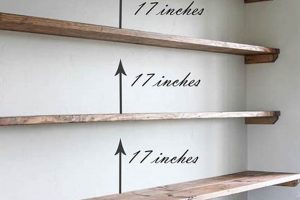Construction of a textured panel intended for tactile and visual stimulation is a project undertaken typically to benefit individuals with sensory processing challenges or developmental disabilities. This activity involves assembling a variety of materials with different textures, colors, and functionalities onto a stable backing, creating a stimulating and engaging experience. An example includes mounting various fabrics, switches, zippers, and brushes onto a wooden board.
The creation of these panels offers numerous advantages, promoting sensory exploration, cognitive development, and fine motor skill improvement. These panels provide a safe and controlled environment for individuals to explore different sensations, leading to increased self-awareness and regulation. Historically, these tools have been used in therapeutic settings and are increasingly implemented in homes and educational environments to support inclusive learning and development.
This article will delve into the practical aspects of building effective sensory panels, covering material selection, design considerations, safety protocols, and potential applications within various contexts. Exploration of these elements is crucial for maximizing the benefits derived from such an interactive tool.
Construction Advice
The following recommendations aim to guide the effective and safe assembly of a sensory panel, ensuring optimal stimulation and developmental support for the intended user.
Tip 1: Material Selection: Prioritize diverse tactile elements. Incorporate materials such as textured fabrics (corduroy, fleece, burlap), smooth surfaces (metal, acrylic), and natural items (wood, stone). This variability enhances sensory exploration.
Tip 2: Secure Attachment: Employ robust fastening methods. Screws, bolts, and industrial-strength adhesives are preferable to ensure materials remain firmly affixed. Regularly inspect for loose components to prevent hazards.
Tip 3: Height Considerations: Adapt the panel’s height to the user’s reach. Mounting the panel at an accessible level promotes independent exploration and reduces the risk of strain or injury.
Tip 4: Visual Stimulation: Integrate contrasting colors and patterns. High-contrast visuals enhance engagement, especially for individuals with visual impairments. Consider incorporating reflective surfaces and light-emitting diodes (LEDs).
Tip 5: Functional Elements: Include interactive components. Switches, buttons, zippers, and latches promote fine motor skill development and cognitive engagement. Ensure all functional elements operate smoothly and safely.
Tip 6: Safety Assessment: Conduct a thorough safety evaluation. Eliminate sharp edges, pinch points, and small, detachable parts that could pose a choking hazard. Prioritize non-toxic materials and finishes.
Tip 7: Durability Testing: Subject the panel to rigorous durability testing. Evaluate its resistance to wear, tear, and impact. Reinforce weak points and replace damaged components promptly.
Careful adherence to these guidelines will result in a safe and effective sensory panel, promoting sensory integration and development. This resource aims to facilitate the creation of a stimulating and beneficial tool for individuals with sensory needs.
The subsequent sections will explore specific design considerations and applications of customized tactile panels in various therapeutic and educational settings.
1. Material Safety
Material safety forms the bedrock of responsible sensory wall construction. The selection of appropriate materials directly impacts the health and well-being of the individual interacting with the structure. Thorough consideration of material properties is not merely advisable, but essential for creating a safe and beneficial sensory experience.
- Toxicity Assessment
Prior to incorporation, each material should undergo a rigorous toxicity assessment. This evaluation must confirm the absence of hazardous chemicals, heavy metals, or volatile organic compounds (VOCs) that could pose risks through inhalation, ingestion, or dermal contact. Example: Opting for water-based paints over solvent-based alternatives mitigates VOC exposure. Failure to conduct this assessment can lead to adverse health effects, particularly in vulnerable populations.
- Durability and Structural Integrity
Materials must exhibit adequate durability to withstand prolonged use and potential rough handling. Structural integrity is crucial to prevent breakage, splintering, or the release of small parts that could present choking hazards. Example: Selecting solid wood over particleboard for structural components enhances durability and reduces the risk of disintegration. Compromised structural integrity negates the benefits of sensory stimulation and introduces significant safety risks.
- Flame Retardancy
In environments where fire risk is a concern, flame-retardant materials are paramount. The incorporation of inherently flame-resistant fabrics and treated wood can significantly reduce the spread of fire and provide valuable time for evacuation. Example: Utilizing inherently flame-retardant fabrics like modacrylic or treating natural fabrics with appropriate flame retardants adds a layer of protection. Neglecting flame retardancy can have devastating consequences in the event of a fire.
- Allergen Awareness
Awareness of potential allergens is crucial during the design and construction phase. Materials known to trigger allergic reactions in susceptible individuals should be avoided. Example: Alternatives to latex, such as nitrile or silicone, should be used in instances where elasticity or grip is required. Thorough vetting of material composition can prevent unnecessary allergic reactions and ensure inclusivity.
The facets of material safety collectively underscore the critical importance of careful selection in constructing sensory walls. A proactive and informed approach mitigates potential hazards, ensuring that these structures remain safe, therapeutic, and beneficial for all users. By emphasizing safety, we can unlock the full potential of sensory walls as tools for development and engagement.
2. Tactile Variety
Tactile variety, in the context of sensory wall construction, represents a pivotal element influencing the panel’s overall effectiveness. A sensory wall’s primary purpose is to provide a range of tactile experiences, and the degree of variety directly impacts the breadth and depth of sensory input received by the user. The cause-and-effect relationship is straightforward: greater tactile variety leads to a more diverse and stimulating sensory experience. For instance, a wall incorporating only smooth surfaces provides limited tactile information compared to one that integrates smooth metal, rough burlap, and flexible rubber. The inclusion of diverse textures is not merely aesthetic; it is fundamental to the wall’s function as a tool for sensory exploration and integration.
Real-life examples illustrate the practical significance of tactile variety. Consider a sensory wall designed for children with autism spectrum disorder. Such a wall might incorporate textures ranging from soft plush to coarse sandpaper, allowing the child to explore and differentiate between various tactile sensations. The intentional inclusion of textures that provide both comfortable and slightly challenging stimuli can aid in desensitization and sensory regulation. Furthermore, a panel designed for geriatric care might focus on familiar textures from earlier in life, such as wool or polished wood, to evoke positive memories and provide a sense of comfort. These examples highlight how tactile variety can be tailored to specific needs and goals.
In summary, tactile variety is an indispensable component of sensory wall design. A lack of diversity in textures diminishes the wall’s capacity to provide meaningful sensory input, while a well-planned array of textures enhances its therapeutic and developmental potential. Challenges may arise in identifying and sourcing appropriate materials that are both stimulating and safe. Overcoming these challenges through careful planning and material selection ensures that the sensory wall serves its intended purpose of promoting sensory exploration, integration, and regulation. A commitment to tactile diversity transforms a simple construction project into a powerful tool for enhancing well-being.
3. Secure Construction
Secure construction is a non-negotiable element within the realm of sensory wall DIY. The purpose of a sensory wall is to offer a stimulating and therapeutic experience; however, this objective cannot be achieved if the structure and its components are unstable. The connection between secure construction and a functional sensory wall is direct: inadequate attachment methods and inferior materials can lead to component detachment, posing significant safety hazards. For example, loosely affixed small objects present a choking risk, while protruding sharp edges can cause injury. Prioritizing robust construction techniques mitigates these dangers and ensures the wall’s longevity and usability.
The practical significance of secure construction extends beyond immediate safety. A well-constructed sensory wall withstands repeated use and exploration, retaining its integrity over time. Consider a sensory wall in a pediatric occupational therapy clinic. It must endure frequent interaction from children with varying motor skills and behaviors. Securely fastened elements, such as switches, zippers, and textured panels, are essential for long-term functionality. Regular inspection and maintenance are also crucial components of secure construction, identifying and addressing potential weaknesses before they escalate into hazards. This proactive approach minimizes downtime and ensures the wall remains a reliable therapeutic tool.
In summary, secure construction is intrinsically linked to the overall success of any sensory wall DIY project. Neglecting this aspect compromises user safety, diminishes the wall’s therapeutic value, and reduces its lifespan. Challenges may arise in sourcing appropriate materials and mastering secure attachment techniques. However, these challenges can be overcome through careful planning, research, and adherence to best practices. By prioritizing secure construction, individuals can create safe, durable, and effective sensory walls that promote exploration, learning, and development.
4. Accessibility Height
Accessibility height, in the context of a “sensory wall diy” project, directly influences the user’s ability to interact effectively and safely with the structure. The height at which the wall is mounted or the placement of individual sensory elements determines the level of engagement possible for users of differing physical abilities. For instance, a wall positioned too high excludes wheelchair users or small children, limiting their access to sensory stimulation. Conversely, a wall placed too low may require excessive bending or stooping, potentially causing discomfort or injury to taller individuals. Therefore, careful consideration of accessibility height is not merely a courtesy but a fundamental requirement for creating an inclusive and therapeutic environment.
Specific examples illustrate the practical application of this principle. In a pediatric setting, a sensory wall might feature elements strategically positioned at various heights to accommodate children of different ages and developmental stages. Lower sections could incorporate textures easily reached by toddlers, while upper sections could provide challenges for older children to encourage reaching and stretching. Similarly, in a rehabilitation center, a sensory wall designed for stroke patients might prioritize elements at heights that facilitate upper limb strengthening exercises. The precise placement of these elements, informed by an understanding of accessibility, maximizes the therapeutic benefit for each user. This strategic approach ensures that the sensory wall meets the diverse needs of its intended audience and promotes optimal interaction.
In conclusion, the concept of accessibility height is inextricably linked to the successful implementation of any “sensory wall diy” project. Ignoring this consideration compromises the wall’s inclusivity and therapeutic potential. Challenges in determining the optimal height may arise from the diverse needs of potential users and the constraints of the physical environment. Overcoming these challenges requires careful assessment of the target population and thoughtful design that balances accessibility with functional goals. The outcome is a sensory wall that is not only stimulating and engaging but also safe and accessible for all individuals, regardless of their physical abilities, thereby maximizing its benefits.
5. Visual Stimulation
Visual stimulation, as it pertains to sensory wall construction, represents a critical design consideration. The visual elements incorporated into a sensory wall significantly influence its appeal, engagement potential, and therapeutic effectiveness. The deliberate use of color, contrast, patterns, and light can transform a static panel into a dynamic and captivating sensory experience.
- Color Palette and Contrast
The strategic use of color plays a pivotal role in visual stimulation. High-contrast color combinations, such as black and white or primary colors against neutral backgrounds, enhance visibility and attract attention, particularly for individuals with visual impairments. Conversely, a soothing palette of pastel colors may promote relaxation and reduce sensory overload. Example: A sensory wall designed for children with autism spectrum disorder may benefit from incorporating calming blues and greens to create a visually comforting environment.
- Patterns and Shapes
The inclusion of diverse patterns and shapes introduces visual complexity and encourages exploration. Geometric patterns, organic shapes, and abstract designs can capture attention and stimulate cognitive processing. Repetition and symmetry can provide a sense of order and predictability, while asymmetry and irregularity can foster curiosity and discovery. Example: A sensory wall designed to stimulate cognitive development may incorporate various shapes, sizes, and orientations to challenge visual perception and spatial reasoning.
- Light and Illumination
The integration of light and illumination further enhances visual stimulation. Backlighting, fiber optics, and LED lights can create dynamic effects and add a layer of visual interest. The manipulation of light intensity and color can evoke different moods and emotions. Example: A sensory wall designed for sensory integration therapy may incorporate dimmable lights to create a calming atmosphere or bright, colorful lights to stimulate alertness and engagement. It should also feature light-reactive elements to increase engagement and exploration.
- Moving Elements
The incorporation of moving elements enhances visual stimulation and provides an interactive experience. Spinning objects, cascading beads, or gently swaying fabrics can capture attention and encourage visual tracking. The movement itself can be visually stimulating and can also provide tactile feedback. Example: A sensory wall designed for individuals with attention deficits may incorporate gently moving elements to capture focus and encourage visual engagement.
These facets of visual stimulation collectively contribute to the overall effectiveness of a sensory wall. Integrating these elements thoughtfully and strategically enhances the wall’s ability to engage users, promote sensory exploration, and provide therapeutic benefits. Attention to visual details transforms a simple panel into a powerful tool for sensory integration and cognitive development.
Frequently Asked Questions
This section addresses common inquiries and concerns regarding the construction and implementation of sensory walls, providing clarity and guidance based on established practices and principles.
Question 1: What are the primary safety considerations when undertaking a sensory wall DIY project?
The most critical safety considerations involve material toxicity, secure attachment of components, and the elimination of sharp edges or small detachable parts that could pose a choking hazard. Thorough inspection and selection of non-toxic, durable materials are paramount.
Question 2: How should the height of a sensory wall be determined to ensure accessibility?
The optimal height of a sensory wall is determined by the intended user group. It is imperative to position the wall at a level that allows for comfortable and independent interaction, accommodating the needs of individuals with varying physical abilities, including wheelchair users and individuals with limited reach.
Question 3: What types of materials are most suitable for creating tactile stimulation in a sensory wall?
A diverse range of materials with varying textures is recommended to maximize tactile stimulation. Examples include textured fabrics such as corduroy and burlap, smooth surfaces like metal and acrylic, and natural elements such as wood and stone. Variation is crucial for promoting sensory exploration.
Question 4: How can visual stimulation be effectively incorporated into a sensory wall design?
Visual stimulation can be enhanced through the strategic use of contrasting colors, patterns, and shapes. The incorporation of light-emitting diodes (LEDs) and reflective surfaces can further amplify visual engagement. Consideration should be given to the visual sensitivities of the intended user group.
Question 5: What methods are recommended for securely attaching materials to a sensory wall?
Robust attachment methods, such as screws, bolts, and industrial-strength adhesives, are essential for ensuring the secure affixation of materials. Regular inspection is necessary to identify and rectify any loose components, preventing potential hazards.
Question 6: How frequently should a sensory wall be inspected and maintained?
Sensory walls should undergo routine inspection at least once per month, or more frequently in high-traffic environments. Maintenance should address any loose components, damaged materials, or potential safety hazards promptly. Regular cleaning is also recommended to maintain hygiene and prevent the accumulation of dust or debris.
Adherence to these guidelines promotes the creation of safe, effective, and beneficial sensory walls for individuals with diverse needs. Prioritizing safety, accessibility, and thoughtful design ensures optimal outcomes.
The concluding section will provide practical tips for troubleshooting common challenges encountered during the construction and implementation of sensory walls.
Conclusion
The preceding exploration of sensory wall DIY underscores its potential as a beneficial intervention when executed thoughtfully and responsibly. Critical considerations encompass material safety, secure construction, accessibility height, and the strategic integration of tactile and visual stimuli. Adherence to established guidelines and best practices is paramount to ensure the resulting structure serves its intended purpose of promoting sensory exploration and development without compromising user safety.
The continued evolution of sensory wall DIY necessitates ongoing research and refinement of construction techniques. A commitment to evidence-based practices and a collaborative approach among educators, therapists, and caregivers will further optimize the efficacy and accessibility of these interactive tools. The potential for positive impact on individuals with diverse sensory needs warrants sustained dedication to innovation and responsible implementation within therapeutic and educational contexts.







